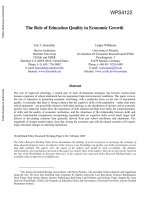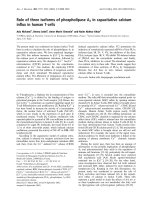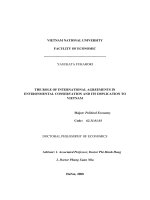Role of phospholipase a2 in orofacial pain and synaptic transmission 1
Bạn đang xem bản rút gọn của tài liệu. Xem và tải ngay bản đầy đủ của tài liệu tại đây (8.01 MB, 118 trang )
ROLE OF PHOSPHOLIPASE A
2
IN OROFACIAL PAIN AND
SYNAPTIC TRANSMISSION
MA MAY THU
(B.Sc. (Hons), NUS)
SUPERVISOR: ASSOCIATE PROFESSOR YEO JIN FEI
A THESIS SUBMITTED FOR THE DEGREE OF
DOCTOR OF PHILOSOPHY
DEPARTMENT OF ORAL AND MAXILOFACIAL SURGERY
FACULTY OF DENTISTRY
NATIONAL UNIVERSITY OF SINGAPORE
2011
Acknowledgements
II
ACKNOWLEDGEMENTS
With thanks to my supervisor, Associate Professor Yeo Jin Fei, Head,
Department of Oral and Maxillofacial, National University of Singapore, who
extended utmost support to my entire project; to my co-supervisor, Associate
Professor Ong Wei Yi, Department of Anatomy, National University of
Singapore, who proposed the topic of my study, provided relentless guidance
throughout my entire candidature and most importantly, influenced me greatly
with his knowledge and passion for research.
Numerous people contributed to the realization of this project: Tang Ning,
for her indefatigable teachings and guidance in my study; Pan Ning, for her
brilliant technical support; Jinatta Jittiwat, Nuntiya Sompran, Chan Yee Gek
and Wu Ya Jun, for their assistance in Electron Microscopy; Chew Wee Siong,
Chia Wan Jie, Ee Sze Min, Guo Jing, Ho Mei Xuan, Kazuhiro Tanaka, Kim Ji
Hyun, Lynette Lee Hui Wen, Lee Li Yen, Amy Lim Seok Wei, Loke Sau Yeen,
Mary Ng Pei Ern, Poh Kay Wee, Tan Yan, Wong Li Ming, Wong Sin Kei,
Yang Hui and Alicia Yap Mei Yi, for their selfless support of my interest in this
study.
Thanks to my mom and dad: Phyu Phyu Win and Htay Aung, who have
always believed I could accomplish my dreams and to my beloved, Wei Ming, for
his partnership and kindness in all things.
Table of Contents
III
TABLE OF CONTENTS
ACKNOWLEDGEMENTS …………………………………… …… ….……………II
TABLE OF CONTENTS………………………………………… ……… ……… III
SUMMARY…………………………………………………….…………… ……VIII
LIST OF TABLES………………………………………………………………… XI
LIST OF FIGURES……………………… ……………………………………… XII
ABBREVIATIONS…………………………………….……………… ……… ….XIV
PUBLICATIONS……………………………….…………… ……….….… … XVIII
SECTION I INTRODUCTION…………………………………………………… … 1
1. Phospholipase A
2
………………………………………………………… …….… 2
1.1. Cytosolic phospholipase A
2
(cPLA
2
)……… ………… … ……… 5
1.2. Ca
2+
-independent phospholipase A
2
(iPLA
2
)………… …… ….….7
1.3. Secretory phospholipase A
2
(sPLA
2
)……………………… ……… 8
1.3.1. sPLA
2
isozymes…………………………………………………9
1.3.1.1. sPLA
2
-IB…………………………………………………… … 9
1.3.1.2. sPLA
2
-IIA……………………………… …………………… 10
1.3.1.3. sPLA
2
-IIC…………………… ……… ……… ………… …11
1.3.1.4. sPLA
2
-IID……………… …………………………… … … 12
1.3.1.5. sPLA
2
-IIE……………… ……….…….………… … ………12
1.3.1.6. sPLA
2
-IIF…………………………………………….… …… 13
1.3.1.7. sPLA
2
-III………….…………….….……………………….… 13
1.3.1.8. sPLA
2
-V……………………………………….… …….………14
Table of Contents
IV
1.3.1.9. sPLA
2
-X……… …………………………………….…………15
1.3.2. sPLA
2
-XIIA…………………………… ………………………16
1.4. Arachidonic acid……………………………… ……………………18
1.5. Phospholipids and lysophospholipids……………… …… ………20
1.6. Exocytosis…………………………… ……………… …………….23
1.6.1. PLA
2
and neurotransmission……………….……… … … 25
1.6.2. Phospholipids and neurotransmission……………… … 27
1.6.3. Lysophospholipids and neurotransmission……………… 28
1.6.4. Factors affecting exocytosis-lipid rafts and Ca
2+
….… … 30
2. Pain…………………………………………………………… ………… …… 32
2.1. Orofacial pain………………………………………………… ….….33
2.2. Nociception and nociceptors………………….……… …… … ….33
2.3. Pain models……………………………………….……… …34
2.4. Pain pathways………………………………………………… …….36
3. PLA
2
and inflammatory pain……………………………….……………… ……39
3.1. PLA
2
and receptors………………………….……………………… 45
SECTION II Experimental studies…………………………………………….…… 48
CHAPTER 1 Changes in brain lipids contents after carrageenan-induced
orofacial pain…………………………………………………………….…………… 49
1.1. Introduction……………………………………………… ……………50
1.2. Materials and methods……………………………………….……….52
1.2.1. Time course study of pain responses after facial CA
injection…………………………………………………………… 52
Table of Contents
V
1.2.2. Assessment of responses to mechanical stimulation………53
1.2.3. Lipidomics analyses……………………………………………54
1.2.3.1. Internal standard…………………………………… 55
1.2.3.2. Lipid extraction……………………………………….55
1.2.3.3. Analysis of lipids using liquid chromatography/mass
spectrometry……………………………………………………56
1.3. Results……………………………… ………………………… ……57
1.3.1. Time course study of pain responses after facial CA
injection…………………………………………………………………57
1.3.2. Lipidomics analyses………………………………………… 58
1.4. Discussion…………………………………………… ……….………64
CHAPTER 2 Differential expression pattern of PLA
2
isoforms in CNS after
orofacial pain ………….………………………………………………… ………… 67
2.1. Introduction……………………………………………………… ……68
2.2. Materials and methods……………………………………………… 70
2.2.1. Real-time RT-PCR…………………………………………… 70
2.2.2. Western blot analysis………………………………………… 71
2.2.3. Immunohistochemistry…………… ………………………… 72
2.3. Results…………………… …………………………………… ……74
2.3.1. mRNA expression of PLA
2
isoforms in the medulla
oblongata……………………………………………………………….74
2.3.2. sPLA
2
-III protein expression and localization in the CM… 76
2.4. Discussion………………………………………………… ……….…78
Table of Contents
VI
CHAPTER 3 Role of group III sPLA
2
in nociception and synaptic transmission in
the CNS…………………………………………………………………………………81
3.1. Introduction……………………………………………………… ……82
3.2. Materials and methods……………………………………………… 85
3.2.1. Real-time RT-PCR…………………………………………… 85
3.2.2. Western blot analysis………………………………………… 86
3.2.3. Immunohistochemistry…………….………………………… 87
3.2.4. Electron microscopy……………………………………………88
3.2.5. Capacitance measurement……………………………………88
3.2.6. Intracellular Ca
2+
imaging………………… ………………….90
3.3. Results………………………… ………………………… …………92
3.3.1. Differential expression of sPLA
2
-III in rat CNS…….……… 92
3.3.2. Western blot analysis of sPLA
2
-III……………….……………93
3.3.3. Immunohistochemistry…………………………………………95
3.3.4. Electron microscopy……………………………………………97
3.3.5. Capacitance measurements……………………………… …98
3.3.6. Intracellular Ca
2+
imaging…………………….…………… 99
3.4. Discussion……………………………………………………….……101
CHAPTER 4 Role of group IIA sPLA
2
in nociception………………… …….…105
4.1. Introduction……………………………………………………………106
4.2. Materials and methods………………………………………………109
4.2.1. Real-time RT-PCR……………………………………………109
4.2.2. Western blot analysis…………………………………………110
Table of Contents
VII
4.2.3. Immunohistochemistry……………………………………….111
4.2.4. Electron microscopy………………………………………….112
4.3. Results…………… …………………………………………………113
4.3.1. Real-time RT PCR……………………………………………113
4.3.2. Western blot analysis…………………………………………117
4.3.3. Immunohistochemistry……………………………………….118
4.3.4. Electron microscopy………………………………………….121
4.4. Discussion…………………………………………………………….123
CHAPTER 5 Role of lysophospholipids in synaptic transmission…… ……….127
5.1. Introduction……………………………………………………………128
5.2. Materials and methods………………………………………………131
5.2.1. TIRFM………………………………………………………….131
5.2.2. Capacitance measurements…………………………………132
5.2.3. Amperometry measurements……………………………… 133
5.2.4. Intracellular Ca
2+
imaging……………………….………… 134
5.3. Results…………………………… …………………………………136
5.3.1. TIRFM………………………………………………………….136
5.3.2. Capacitance measurements…………………………………138
5.3.3. Amperometry measurements……………………………… 141
5.3.4. Intracellular Ca
2+
imaging……………………….………… 143
5.4. Discussion…………………………………………………………….144
SECTION IV CONCLUSION……………………………………………………… 149
SECTION V REFERENCES……………………………………………………… 154
Summary
VIII
SUMMARY
Phospholipase A
2
(PLA
2
, EC 3.1.1.4) are enzymes which hydrolyze the
acyl ester bond at the sn-2 position to generate free fatty acids such as
arachidonic acid (AA) and lysophospholipids, from membrane
glycerophospholipids. PLA
2
isoforms include secretory phospholipase A
2
(sPLA
2
), cytosolic phospholipase A
2
(cPLA
2
) and Ca
2+
-independent
phospholipase A
2
(iPLA
2
). Although emerging evidences have shown the roles of
PLA
2
isoforms in nociception, direct evidences which indicate altered brain PLA
2
activity and expression during allodynia or hyperalgesia are lacking. The function
of PLA
2
during nociceptive transmission also needs to be explored.
The present study elucidated changes in brain lipids in medulla oblongata
after orofacial pain induced by facial carrageenan (CA) injection. The caudal
medulla oblongata (CM) showed decreases in phospholipids including
phosphatidylethanolamine and phosphatidylinositol (PI) and increases in their
corresponding lysophospholipids, lysophosphatidylethanolamine and
lysophosphatidylinositol (lysoPI). These results indicated an enhanced PLA
2
activity in the CM and release of AA after peripheral inflammation of the face.
This study further examined changes in expression level of PLA
2
isoforms after
nociception. mRNA expression of sPLA
2
-III was highly expressed in the CM and
this expression was significantly increased in the CA-injected rats. However, no
corresponding increase in sPLA
2
-III protein expression was detected. These
changes possibly take place in spinal trigeminal nucleus which communicates
Summary
IX
nociceptive input from orofacial region, indicating the nociceptive function of
sPLA
2
-III.
The expression profile of sPLA
2
-III in CNS and its effects on exocytosis in
rat PC-12 cells further illustrated the role of sPLA
2
-III in pain transmission. Both
sPLA
2
-III mRNA and protein expression were expressed at the highest levels in
the brainstem and spinal segments. The enzyme was localized to dendrites in
spinal trigeminal nucleus, supporting its role in ascending pain pathway. External
application of sPLA
2
-III to PC-12 cells augmented capacitance measurement,
indicating exocytosis and this was dependent on lipid rafts and external Ca
2+
.
Moreover, sPLA
2
-III caused an increased in intracellular Ca
2+
([Ca
2+
]i), indicating
that it could be a trigger for exocytosis. Moreover, sPLA
2
-IIA with a strong
secretory signal, showed high levels of mRNA and protein in the brainstem and
spinal segments. sPLA
2
-IIA was also localized to the dendrites in spinal
trigeminal nucleus and dorsal horn of spinal cord. The expressions of sPLA
2
-IIA
were supported by previous studies which also illustrated a significant function of
CNS sPLA
2
in nociceptive transmission.
PLA
2
participates in the synaptic transmission through its secretion, i.e. in
sPLA
2
-III and -IIA, and also via its enzymatic product, lysophospholipids. When
the effects of lysophospholipids on exocytosis in PC-12 cells were elucidated,
external infusion of lysoPI augmented vesicle fusion, indicating exocytosis.
Similarly, significant increase in capacitance measurement, or number of spikes
detected at amperometry, indicating exocytosis was observed after external
Summary
X
application of lysoPI. This process was affected by the lipid rafts and [Ca
2+
]i.
LysoPI also caused an elevated [Ca
2+
]i, implying its effect on exocytosis.
In conclusion, this study demonstrated significantly increased PLA
2
activity
and expression upon orofacial pain. Moreover, due to their localization and roles
in synaptic transmission, both sPLA
2
-III and sPLA
2
-IIA are found to be important
isozymes in the ascending pain pathway.
List of Tables
XI
LIST OF TABLES
SECTION I
Table.1.1. Summary of differential mRNA and protein expression of PLA
2
isoforms in the CNS and peripheral organs based on various previous studies 17
SECTION II
Table.2.1.1. Changes in selected lipids in the RM and CM after facial CA
injection…….…………………………………………………………………………………. 59
Table.2.4.1. Comparison of sPLA
2
isoforms mRNA and protein expression in rat
CNS between previous reports and current findings ……………………… … 116
List of Figures
XII
LIST OF FIGURES
SECTION I
Figure.1.1. Site of action of phospholipase A
1
, A
2
, C and D on the phospholipid
molecule………………………………………………………………………………….3
Figure.1.4.1. Chemical structure of AA …………………………………………….19
Figure.1.5.1. Schematic diagrams of structures of lysophospholipids …….……22
Figure.1.6.1 Schematic diagram of neurotransmission ……….…………………24
Figure.2.3.1 Schematic diagram of structure of carrageenan…… ……… …35
Figure 2.4.1. Schematic diagram of pain pathway …………………………… 38
SECTION II
Figure.2.1.1. Responses to von Frey hair stimulation of the face after tissue
inflammation induced by CA injection ………………………………………………57
Figure.2.1.2. Lipidomic analysis of changes in selected lipids in right half of CM
sacrificed at 3 days post-CA injection ……………… ………………… …………61
Figure.2.1.3. Lipidomic analysis of changes in selected lipids in right half of CM
sacrificed at 3 days post-CA injection……………………………………… … ….63
Figure.2.2.1. Real-time RT PCR analysis of differentially expressed PLA
2
subgroups in the RM and CM…………………………… ………………… …….75
Figure.2.2.2. Western blot analyses of sPLA
2
-III protein expression in different
parts of the rat CM and light micrographs of sPLA
2
-III immunolabeled sections
from normal and CA-injected rat CM.………………………………… ……… … 77
Figure.2.3.1. Protein sequence of the human group III PLA
2
………….…………83
Figure.2.3.2. Real-time RT-PCR analysis of sPLA
2
-III in the various parts of
CNS 92
Figure.2.3.3. Western blot analyses of sPLA
2
-III protein expression in different
areas of the rat CNS ……………………………………………………….…………94
List of Figures
XIII
Figure.2.3.4. Light micrographs of sPLA
2
-III immunolabeled sections from a
normal rat CNS ……………………………………………… ………… …….……95
Figure.2.3.5. Light micrographs of sPLA
2
-III immunolabeled sections from a
normal rat CNS ……………………………………………………………………… 96
Figure.2.3.6. Electron micrographs of sPLA
2
-III immunolabeled sections from the
spinal cord of a normal rat ………………………………….……………………… 97
Figure.2.3.7. Increase in membrane capacitance in a PC-12 cell indicating
exocytosis, after addition of sPLA
2
-III ……………………………………… …… 99
Figure.2.3.8. Intracellular calcium imaging…………………………… …… …100
Figure.2.4.1. Real-time RT-PCR analysis of differentially expressed sPLA
2
subgroups in the CNS ………………………………………………………………114
Figure.2.4.2. Western blot analyses of sPLA
2
-IIA protein expression in different
parts of the rat CNS. ………………………………………………………… ……117
Figure.2.4.3. Light micrographs of sPLA
2
-IIA immunolabeled sections from a
normal rat CNS … ………………………………………………………….………118
Figure.2.4.4. Light micrographs of sPLA
2
-IIA immunolabeled sections from a
normal rat CNS … ………………………………………………………….………120
Figure.2.4.5. Electron micrographs of sPLA
2
-IIA immunolabeled sections from
the dorsal horn of the spinal cord of a normal rat ………….…………….………122
Figure.2.5.1. TIRFM imaging of vesicles footprints and fusion events happened
at subplasmalemmal region ………………………… ……………… …………137
Figure.2.5.2. Capacitance measurements after addition of
lysophospholipids…………………………………………………………………….140
Figure.2.5.3. Capacitance measurements after various treatments ……… …141
Figure.2.5.4. Amperometry measurements ……………… ………………….…142
Figure.2.5.5. Intracellular calcium imaging ……………………………….………143
Abbreviations
XIV
ABBREVIATIONS
AA Arachidonic acid
AACOCF
3
Arachidonyl trifluoromethyl ketone
AD Alzheimer’s disease
AMPA 2-amino-3-(5-methyl-3-oxo-1,2-oxazol-4yl)propanoic acid
ATP Adenosine triphosphate
ATPase Adenine triphosphatase
BEL Bromoenol lactone
Ca
2+
Calcium
[Ca
2+]
i Intracellular calcium
CA Carrageenan
Cer Ceramide
CICR Calcium- induced calcium release
CM Caudal portion of medulla oblongata
CMC Critical micelle concentration
CNS Central nervous system
CoA Coenzyme A
COX Cyclooxygenase
cPLA
2
Calcium-dependent cytosolic phospholipase A
2
DAB 3,3-diaminobenzidine tetrahydrochloride
DAG Diacylglcerol
DHA Docosahexaenoic acid
Abbreviations
XV
DRG Dorsal root ganglion
EAAs Excitatory neurotransmitter amino acids
EDTA Ethylenediaminetetraacetic acid
EGFP Enhanced green fluorescence protein
EGFR Epidermal growth factor receptors
GFP Green fluorescent protein
GPI Glycosylphosphatidylinositol
HPLC High performance liquid chromatography
I.C.V. Intracerebroventricular
IL-1 Interleukin-1
iNOS Nitric oxide synthase
iPLA
2
Calcium-independent phospholipase A
2
IT Intrathecal
K
+
Potassium
LysoPA Lysophosphatidic acid
LysoPC Lysophosphatidylcholine
LysoPE Lysophosphatidylethanolamine
LysoPI Lysophosphatidylinositol
LysoPS Lysophosphatidylserine
LPS Lipopolysaccharide
LTP Long-term potentiation
L-VSCCs L-type voltage sensitive calcium channels
MAPK Mitogen activated protein kinases
Abbreviations
XVI
MBCD Methyl-beta-cyclodextrin
mM Millimolar
Na
+
Sodium
NADPH Nicotinamide adenine dinucleotide phosphate
NMDA N-methyl-D-aspartic acid
NPY Neuropeptide Y
NSAIDs Non-steroid anti-inflammatory drugs
OA Osteoarthritis
OGD Oxygen glucose deprivation
PA Phosphatidic acid
PAF Platelet activating factor
PBS Phosphate-buffered saline
PC Phosphatidylcholine
PC-12 Pheochromocytoma-12
PD Parkinson’s disease
PE Phosphatidylethanolamine
PG Phosphatidylglycerol
PGE
2
Prostaglandin E
2
PH Pleckstrin homology
PI Phosphatidylinositol
PI-4,5-P
2
Phosphatidylinositol 4,5-bisphosphate
PKA Protein kinase A
PKC Protein kinase C
Abbreviations
XVII
PLA
2
Phospholipase A
2
PLC Phospholipase C
PLD Phospholipase D
PS Phosphatidylserine
PVDF Polyvinylidene difluoride
RA Rheumatoid arthritis
RM Rostral portion of medulla oblongata
SCI Spinal cord injury
SL Sulfatide
SM Sphingomyelin
SNAP-25 Synaptosomal-associated protein of 25 kDa
SNARE Soluble N-ethylmaleimide-sensitive factor attachment protein
receptor
SPANs Snake presynaptic phospholipase A
2
neurotoxins
sPLA
2
Secretory phospholipase A
2
STN Spinal trigeminal nucleus
TBS Tris-buffered saline
TTBS Tween-20 TBS
Tg Transgenic
TIRFM Total internal reflection microscopy
TNF-α Tumor necrosis factor-alpha
TTXR Tetrodotoxin-resistant
UTP Uridine triphosphate
VAMP Vesicle-associated membrane protein
Publications
XVIII
PUBLICATIONS
Several parts of this study have been published in international refereed journals.
International Refereed Journals
1. Ma MT, Yeo JF, Farooqui AA, Zhang J, Chen P, Ong WY (2010) Differential
effects of lysophospholipids on exocytosis in rat PC-12 cells. J Neural
Transm 117:301-308
2. Ma MT, Nevalainen TJ, Yeo JF, Ong WY (2010) Expression profile of multiple
secretory phospholipase A(2) isoforms in the rat CNS: enriched
expression of sPLA(2)-IIA in brainstem and spinal cord. J Chem
Neuroanat 39:242-247
3. Ma MT, Zhang J, Farooqui AA, Chen P, Ong WY (2010) Effects of cholesterol
oxidation products on exocytosis. Neurosci Lett 476:36-41
4. Ma
MT, Yeo
JF, Farooqui
AA, Ong
WY (2011) Role of Calcium Independent
Phospholipase A2 in Maintaining Mitochondrial Membrane Potential and
Preventing Excessive Exocytosis in PC12 Cells. Neurochem Res 36:347-
354
5. Ma
MT, Shui
G, Wenk
MR, Yeo
JF, Ong
WY (2011) Systems wide analyses of
lipids in the brainstem during inflammatory orofacial pain – evidence for
increased phospholipase A2 activity. Eur J Pain 16:38-48
6. Yang H, Ma MT, Siddiqi NJ, Alhomida
AS, Ong
WY (2011) Enriched
expression profile of sPLA
2
-III in rat CNS and its effects on exocytosis in
PC12 cells. Neuroscience (submitted)
Section I
Introduction
1
SECTION I
INTRODUCTION
Section I
Introduction
2
1. Phospholipase A
2
Phospholipase A
2
(PLA
2
, EC 3.1.1.4) consists of a superfamily of enzymes
which specifically hydrolyze the acyl ester bond at the sn-2 position to liberate
free fatty acids, such as arachidonic acid (AA) and lysophospholipids, from
glycerol in membrane phospholipids (Fig. 1.1.1.). Different isoforms of PLA
2
enzymes exists, including secretory phospholipase A
2
(sPLA
2
), calcium (Ca
2+
)-
dependent cytosolic phospholipase A
2
(cPLA
2
), and Ca
2+
-independent
phospholipase A
2
(iPLA
2
) (Balsinde and Dennis 1996; Akiba and Sato 2004).
These isoforms are differentiated according to their cellular localization, and
activation pathways (Zhu et al. 1996) and they play different roles in the central
nervous system (CNS). Studies have related the role of cPLA
2
to modulating
neuronal excitatory functions while sPLA
2
to inflammatory responses, and iPLA
2
is more widely studied in neurologic disorders associated with brain iron
accumulation which normally occur during childhood and has been associated
with Schizophrenia (Ong et al. 2010; Sun et al. 2010). cPLA
2
and sPLA
2
are
more commonly associated with many inflammatory diseases (Mayer and
Marshall 1993).
Section I
Introduction
3
Fig.1.1.Site of action of phospholipases A
1
, A
2
, C and D on the phospholipid molecule to produce
lysophospholipids and arachidonic acid (Farooqui and Horrocks 2007).
Secreted sPLA
2
acts on the cells extracellularly to liberate AA, which is
then taken up by cells almost immediately. Activation of this enzyme stimulates
cPLA
2
which acts intracellularly, on the nuclear membrane and/or endoplasmic
reticulum to release AA inside the cell (Balsinde et al. 1994). iPLA
2
is involved in
phospholipid remodeling as it hydrolyzes membrane phospholipids in a Ca
2+
-
independent manner. Lysophospholipids, product from enzymatic action of
iPLA
2
, are substrates for acyl transferases necessary for incorporation of
unsaturated fatty acids, AA, to produce phospholipids. These are required for
cyclooxygenas
e
Prostaglandins
Thromboxane
s
Lipoxins
Leukotriene
s
Epoxides
Fatty
acid
Alcohols
lipooxygenas
e
cytochromeP45
0
PAFsynthas
e
PA
F
Arachidonic
acid
Lysophospholipid
s
Lysoplatelet –activating
factor
(Lyso
-
PAF)
Section I
Introduction
4
stimulation for sPLA
2
and cPLA
2
, suggesting the significance of iPLA
2
physiological function in basal cell metabolism (Dennis 1997).
Both membrane phospholipids and their hydrolytic products are essential
for signal transduction pathway in the cells. Phospholipids are precursors of
diacylglycerol (DAG) which triggers protein kinase C (PKC) production after its
translocation to the membranes (Farooqui et al. 1988). DAG induces addition of
regulatory domain of PKC into the hydrophobic core of membranes (Orr and
Newton 1992) likely through altering the properties of membrane lipid bilayer
(Senisterra and Epand 1993). Moreover, DAG is involved in neurotransmission
as it induces membrane fusion (Nieva et al. 1989) associated with
neurotransmitter release.
Phospholipids such as phosphatidylcholine (PC),
phosphatidylethanolamine (PE), phosphatidylserine (PS) and
phosphatidylinositol (PI) are hydrolyzed according to specific PLA
2
activities to
their respective lysophospholipids which reside on the neural membrane
(Farooqui et al. 1997b; Farooqui et al. 2000b). Different phospholipids exert a
variety of influences on the cell membranes, such as inducing neural
transmission and cell excitotoxicity. For instance, PS regulates binding ability of
glutamate receptors necessary for maintaining the long-term potentiation (LTP) in
both neonatal and adult rat brain (Baudry et al. 1991; Gagne et al. 1996).
However, the production of PS in cerebellar slices is blocked by metabotropic
glutamate receptor agonist (Buratta et al. 2004), suggesting that the
metabotropic glutamate receptor activation reduces the insertion of serine into
Section I
Introduction
5
PS and influences the production of excitatory postsynaptic currents in rat
cerebellar slices (Farooqui and Horrocks 2007).
Lysophospholipids are generated either through hydrolysis action of
lysophospholipase or by recycling of phospholipids in remodeling pathway
(Farooqui et al. 2000a). The main function of these lipids is to alter membrane
fluidity and permeability and to exert phospholipid remodeling and membrane
perturbation (Farooqui and Horrocks 2006). AA, another enzymatic product due
to action of PLA
2
on phospholipids, has a small portion of it converted to
inflammatory mediators such as prostaglandin E
2
(PGE
2
), leukotrienes and
thromboxanes while most of it is reincorporated into brain glycerophospholipids
during physiological conditions (Leslie 2004). AA is a precursor for pro-
inflammatory mediators and regulates neural cell function directly by changing
the fluidity and polarization state of membranes through stimulating PKC and
triggering the release of Ca
2+
(Molloy et al. 1998).
1.1. cPLA
2
Another PLA
2
isoform, cPLA
2
, has a molecular weight of 85 kDa and is
highly distributed throughout rat CNS (Ong et al. 1999b). In contrast to sPLA
2
,
this enzyme preferred AA in the sn-2 position of phospholipid substrates (Diez et
al. 1992; Dennis 1997) precursors for various pro-inflammatory lipid mediators
including prostaglandins and leukotrienes (Roshak et al. 1994; Naraba et al.
1998; Farooqui et al. 2004). cPLA
2
is transcribed in almost all peripheral tissues,
although the pancreas, liver, heart and kidney exhibit very low levels of cPLA
2
Section I
Introduction
6
expression (Molloy et al. 1998). cPLA
2
mRNA is expressed at the highest levels
in most regions of the brain including the brainstem, hippocampus, striatum,
spinal cord, midbrain and cerebellum using quantitative PCR using Western blot
and cPLA
2
activity assay (Shirai and Ito 2004; Lucas et al. 2005; Ong et al.
2010). cPLA
2
immunoreactivity is detected in the dorsal and ventral horns of the
spinal cord (Ong et al. 1999a), in which the enzyme protein is localized in
dendrites or dendritic spines that are postsynaptic to unlabeled axon terminals
(Sandhya et al. 1998; Ong et al. 1999a).
In addition, this enzyme is localized in facial motor nucleus of the
brainstem and initial parts in the ascending auditory pathway including cochlear
nuclei (Sandhya et al. 1998; Kishimoto et al. 1999; Ong et al. 1999b; Farooqui
2000; Shirai and Ito 2004) suggesting that cPLA
2
is also important in pain
pathway. cPLA
2
is involved in spinal nociceptive processing as cPLA
2
activity in
the spinal homogenates is significantly reduced after intrathecal (IT) injection of
cPLA
2
inhibitors (Lucas et al. 2005). Although cPLA
2
gene expression is low in
the hippocampus, olfactory bulb and cerebellar granular cells, its activity is
upregulated in the dentate granule gyrus after brain ischemia (Koike et al. 1997).
This upregulation contributes to degradation of neural membrane phospholipids
which results in production of AA-derived lipid metabolites that are implicated in
nociception, neuroinflammation, oxidative stress and neurodegeneration (Ong et
al. 2010).
Section I
Introduction
7
1.2. iPLA
2
iPLA
2
(80 kDa), is possibly the highest level of PLA
2
that could be
expressed in the cells. Its activity is present in the brain cytosolic fraction and has
no significant fatty acid specificity (Ong et al. 2005; Ong et al. 2010). The key
function of this isoform is in membrane remodeling, although it is also implicated
in AA release (Balsinde et al. 1997; Akiba et al. 1998; Ramanadham et al. 1999)
and involves indirectly in leukotriene synthesis (Larsson et al. 1998).
iPLA
2
mRNA is expressed in all tissues, with higher level of expression in
all regions of the CNS compared to the rest of the organs (Lucas et al. 2005).
iPLA
2
protein is densely localized in the forebrain, particularly in cortex,
hippocampus and striatum (Ong et al. 2005). High level of iPLA
2
immunoreactivity is observed in the hippocampus, cerebellum, and brainstem,
with low levels of expression detected in the thalamus and hypothalamus (Shirai
and Ito 2004; Ong et al. 2005). iPLA
2
is localized on the nuclear envelop of
neurons, dendrites, and axon terminals (Ong et al. 2005). At the periphery, iPLA
2
mRNA expression is expressed at low level in the pancreas, testis and spleen
(Molloy et al. 1998). In the astrocytes, cAMP/PKA pathway leads to activation of
iPLA
2
by stimulus and generation of docosahexaenoic acid (DHA) (Strokin et al.
2006). In rat hippocampal slices, iPLA
2
and DHA could give neuroprotection
against toxicity from oxygen glucose deprivation (OGD) (Strokin et al. 2006).
iPLA
2
has an important “housekeeping” role during physiological
conditions, in which iPLA
2
activity is essential for prevention of vacuous chewing
movements which is a rodent model for tardive dyskinesia. Deficits in prepulse









